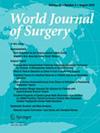对有广泛淋巴结转移的 4 型或大型 3 型胃癌进行新辅助化疗后的主动脉旁淋巴结清扫术。
IF 2.3
3区 医学
Q2 SURGERY
引用次数: 0
摘要
背景据报道,新辅助化疗(NAC)后的主动脉旁淋巴结清扫术(PAND)对有广泛淋巴结转移(ELM)的胃癌(GC)有效。然而,以往的研究排除了4型和大型3型肿瘤,因为它们被认为是容易扩散到腹膜的特殊亚型。因此,PAND是否有助于4型或大的3型GC伴ELM的生存尚不清楚。方法本研究对2002年至2019年期间接受根治性胃切除术并行D2切除和PAND后接受NAC的患者进行了研究。患者被分为正常类型组和4型或大3型组。结果49例患者接受了检查,并被分为正常型组(34例)和4型或大3型组(15例)。正常类型组和 4 型或大型 3 型组的 5 年生存率分别为 55.5%和 26.7%。结论在多变量分析中,4型或大型3型肿瘤是预后不良的独立危险因素(危险比:2.506,95%置信区间:1.111-5.650,P = 0.027)。带有ELM的4型或大型3型GC应采用与带有ELM的正常类型不同的策略进行治疗。本文章由计算机程序翻译,如有差异,请以英文原文为准。
Para-aortic lymph node dissection following neoadjuvant chemotherapy for type 4 or large type 3 gastric cancer with extensive lymph node metastasis.
BACKGROUND
D2 and para-aortic lymph node dissection (PAND) following neoadjuvant chemotherapy (NAC) are reportedly effective for gastric cancer (GC) with extensive lymph node metastasis (ELM), such as para-aortic nodal metastasis or bulky nodal metastasis, around the major perigastric arteries. However, type 4 and large type 3 tumors were excluded from previous studies, as they are considered special subtypes that easily spread to the peritoneum. Whether or not PAND contributes to the survival of type 4 or large type 3GC with ELM is thus unclear.
METHODS
This study examined patients who underwent radical gastrectomy with D2 resection and PAND following NAC between 2002 and 2019. Patients were classified into the normal-type group and the type 4 or large type 3 group. The overall survival (OS) and prognostic factors were investigated.
RESULTS
Forty-nine patients were examined and classified into the normal-type group (34 patients) and type 4 or large type 3 group (15 patients). The 5-year OS rates of the normal-type and type 4 or large type 3 groups were 55.5% and 26.7%, respectively. Type 4 or large type 3 tumors were an independent risk factor for a poor prognosis in the multivariate analysis (hazard ratio: 2.506, 95% confidence interval: 1.111-5.650, and p = 0.027).
CONCLUSIONS
The prognosis of type 4 or large type 3 GC with ELM treated with radical gastrectomy with D2 and PAND after NAC was poor. Type 4 or large type 3 GC with ELM should be treated using a different strategy than the normal type with ELM.
求助全文
通过发布文献求助,成功后即可免费获取论文全文。
去求助
来源期刊

World Journal of Surgery
医学-外科
CiteScore
5.10
自引率
3.80%
发文量
460
审稿时长
3 months
期刊介绍:
World Journal of Surgery is the official publication of the International Society of Surgery/Societe Internationale de Chirurgie (iss-sic.com). Under the editorship of Dr. Julie Ann Sosa, World Journal of Surgery provides an in-depth, international forum for the most authoritative information on major clinical problems in the fields of clinical and experimental surgery, surgical education, and socioeconomic aspects of surgical care. Contributions are reviewed and selected by a group of distinguished surgeons from across the world who make up the Editorial Board.
 求助内容:
求助内容: 应助结果提醒方式:
应助结果提醒方式:


